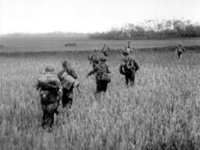
CEFEO insignia bearing the traditional French Navy anchor symbol.
The French Far East Expeditionary Corps (French) was a colonial expeditionary force of the French Union Army that was initially formed in French Indochina during 1945 during the Pacific War. The CEFEO later fought and lost in the First Indochina War against the Viet Minh rebels.
History (1945–1956)[]
Pacific War (1945)[]
The CEFEO was created in early 1945 as a replacement for the older Far East French Expeditionary Forces (Forces Expéditionnaires Françaises d'Extrême-Orient, FEFEO). Its purpose was to support Saigon-based General Gilbert Sabattier, divisional commander of colonial "Indochina French Forces" (Forces Françaises d'Indochine)[1] and Free French Forces resistance small groups C.L.I. then fighting with the Japanese Southern Expeditionary Army Group during the Second French Indochina Campaign. After the 1944 Liberation of France and the fall of Nazi Germany in Europe the following year, the French authorities wanted to "free" the last Axis powers occupied territories in Southeast Asia, these included the newly established Empire of Vietnam, which was a Japanese colony. On June 7, 1945, Leclerc was nominated commander of the CEFEO. On June 22, Leclerc transferred commanding of the 2nd Armored Division (2ème D.B.) -the famous unit who liberated Paris in August 1944- to Colonel Dio. Leclerc received command of the Far East French Forces (Forces Françaises en Extrême-Orient) on August 15.
First Indochina War (1946–1954)[]

Colonial paratroopers in the delta area of northern Vietnam (1952)
In 1946, nationalist, then communist popular rebellion movement rose up against established colonial rule in the French Indochina federation then including the Kingdom of Laos, the Kingdom of Cambodia, Tonkin (North Vietnam), the Empire of Annam (Middle Vietnam) and Cochinchina (South Vietnam), all states being protectorates excluding the latter which was a colony with Saigon as its capital. In 1946, they would become associated states within the French Union and by 1949 Tonkin, Annam and the Republic of Cochin China would merge as the State of Vietnam. The communist Viet Minh led by Ho Chi Minh overwhelmed its rival nationalist movements and organized itself as a guerilla army using guerrilla warfare, then in the 1950s—due to a massive Chinese support—using conventional warfare. The First Indochina War officially lasted from November 20, 1946 until July 20, 1954 and was settled by the Geneva Agreements.
Dissolution (1956)[]
After withdrawal of the last CEFEO troops from the independent Vietnam, Laos and Cambodia in 1956, the corps was disbanded by General Pierre Jacquot.
Composition[]
The CEFEO was made of enlisted and volunteer troops from the French Union colonial territories in Maghreb, Africa, Madagascar, Overseas (future Dom-Tom) and South-East Asia with the notable exception of the French Foreign Legion gathering mostly European troops (French, Spaniards, Poles, and notably Germans etc.).
Most of the professional colonial airborne units (BPC) and the entire Chief of Staff were metropolitan French though.
In early November 1953, the French U.N. volunteers returning from the ended Korean War joined the French Union CEFEO and sailed from Incheon to Vietnam.[2] They would be later involved in the battle of Mang Yang Pass of June and July 1954.
CEFEO commanders[]

CEFEO shoulder patch insignia bearing the "Far East" mark.
- Philippe Leclerc de Hauteclocque (1945–46)
- Jean Etienne Valluy (1946–48)
- Roger Blaizot (1948–49)
- Marcel Carpentier (1949–50)
- Jean de Lattre de Tassigny (1950–51)
- Raoul Salan (1952–53)
- Henri Navarre (1953–54)
- Paul Ély (1954–55)
- Pierre Jacquot (1955–56)
Far East Forces[]
Groupe d'Opération Nord-Ouest (GONO)[]
(North West Operation Group)
- GONO commander: General Christian de Castries (1954)
Forces Terrestres en Extrême-Orient (FTEO)[]
(Far East Ground Forces)
- FTEO commander: -
- Forces Terrestres du Nord Vietnam (FTNV)
(North Vietnam Ground Forces)
- FTNV commander: General René Cogny (1954)
- Forces Terrestres du Sud Vietnam (FTSV)
(South Vietnam Ground Forces)
- FTSV commander: -
Among the French ground forces in the Far East was the 6th Engineers Regiment (6 RG).
Forces Maritimes en Extrême-Orient (FMEO)[]
(Far East Naval Forces)
- FMEO commander:
- Georges Thierry d'Argenlieu (1946–47)
- Emile Bollaert (1947)
- Vice-Admiral Auboyneau (1952–54)
- Direction Navale d'Extrême-Orient (DNEO)
(Far East Naval Direction)
- DNEO commander: Contre-Admiral Bosvieux (1952)
Forces Aériennes en Extrême-Orient (FAEO)[]
(Far East Airforces)
- FAEO commander: -
Notable personnel[]
- Jacques Massu (10e DP)
- Marcel Bigeard (6e BPC)
- Roger Trinquier (GCMA)
- Jean Sassi (GCMA)
- Pierre Schoendoerffer (SCA)
- Raoul Coutard (SPI)
Notes[]
- ↑ Martin Thomas (1997). "Journal of Southeast Asian Studies, Vol. 28, 1997". http://www.questia.com/googleScholar.qst?docId=5000484951. Retrieved 2010-01-02.
- ↑ Departure of the French U.N. Korean battalion, French newsreels archives (Les Actualités Françaises), November 5, 1953
See also[]
- First Indochina War
- French Union
- Vietnamese National Army
External links[]
- CEFEO uniforms
- Indochina Order of Battle, 1 February 1942
- (French) FEFO French resistance in Indochina (1943-1945)
- (French) Veterans federation website
- (French) CEFEO evolution (French Defense archives)
- (French) CEFEO train
The original article can be found at French Far East Expeditionary Corps and the edit history here.